Pho
Phở or pho[2] (UK: /fɜː/, US: /fʌ, foʊ/, Canada: /fɑː/;[3] Vietnamese: [fəː˧˩˧] (![]()
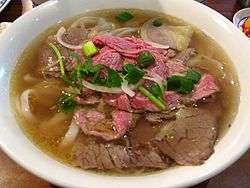 | |
| Alternative names | pot-au-pho |
|---|---|
| Type | Noodle soup |
| Course | Main course |
| Place of origin | Vietnam |
| Region or state | Hanoi |
| Invented | 1900–1907[1] |
| Serving temperature | Warm |
| Main ingredients | Rice noodles and beef or chicken |
| Variations | Phở gà (pho with chicken), phở tái (pho topped with sliced rare beef) |
Pho originated in the early 20th century in northern Vietnam, and was popularized throughout the world by refugees after the Vietnam War. Because Pho's origins are poorly documented,[7][8] there is disagreement over the cultural influences that led to its development in Vietnam, as well as the etymology of the name.[9] The Hanoi (northern) and Saigon (southern) styles of pho differ by noodle width, sweetness of broth, and choice of herbs.
History
Pho likely evolved from similar noodle dishes. For example, villagers in Vân Cù say they ate pho long before the French colonial period.[10] The modern form emerged between 1900 and 1907 in northern Vietnam,[1][7] southeast of Hanoi in Nam Định Province, then a substantial textile market. The traditional home of pho is reputed to be the villages of Vân Cù and Dao Cù (or Giao Cù) in Đông Xuân commune, Nam Trực District, Nam Định Province.[10][11]
Cultural historian and researcher Trịnh Quang Dũng believes that the popularization and origins of modern pho stemmed from the intersection of several historical and cultural factors in the early 20th century.[12] These include improved availability of beef due to French demand, which in turn produced beef bones that were purchased by Chinese workers to make into a dish similar to pho called ngưu nhục phấn.[12][13] The demand for this dish was initially the greatest with workers from the provinces of Yunnan and Guangdong, who had an affinity for the dish due to its similarities to that of their homeland, which eventually popularized and familiarized this dish with the general population.[13]
Pho was originally sold at dawn and dusk by itinerant street vendors, who shouldered mobile kitchens on carrying poles (gánh phở).[14] From the pole hung two wooden cabinets, one housing a cauldron over a wood fire, the other storing noodles, spices, cookware, and space to prepare a bowl of pho. The heavy gánh was always shouldered by men.[15] They kept their heads warm with distinctive, disheveled felt hats called mũ phở.[16]
Hanoi's first two fixed pho stands were a Vietnamese-owned Cát Tường on Cầu Gỗ Street and a Chinese-owned stand in front of Bờ Hồ tram stop. They were joined in 1918 by two more on Quạt Row and Đồng Row.[17] Around 1925, a Vân Cù villager named Vạn opened the first "Nam Định style" pho stand in Hanoi.[18] Gánh phở declined in number around 1936–1946 in favor of stationary eateries.[16]
Development
In the late 1920s, various vendors experimented with húng lìu, sesame oil, tofu, and even Lethocerus indicus extract (cà cuống). This "phở cải lương" failed to enter the mainstream.[17][19]
Phở tái, served with rare beef, had been introduced by 1930. Chicken pho appeared in 1939, possibly because beef was not sold at the markets on Mondays and Fridays at the time.[17]

With the partition of Vietnam in 1954, over a million people fled North Vietnam for South Vietnam. Pho, previously unpopular in the South, suddenly became popular.[11] No longer confined to northern culinary traditions, variations in meat and broth appeared, and additional garnishes, such as lime, mung bean sprouts (giá đỗ), culantro (ngò gai), cinnamon basil (húng quế), Hoisin sauce (tương đen), and hot chili sauce (tương ớt) became standard fare.[7][11][17][20] Phở tái also began to rival fully cooked phở chín in popularity. Migrants from the North similarly popularized bánh mì sandwiches.[21]
Meanwhile, in North Vietnam, private pho restaurants were nationalized (mậu dịch quốc doanh)[22] and began serving pho noodles made from old rice. Street vendors were forced to use noodles made of imported potato flour.[23][24] Officially banned as capitalism, these vendors prized portability, carrying their wares on gánh and setting out plastic stools for customers.[25]
During the so-called "subsidy period" following the Vietnam War, state-owned pho eateries served a meatless variety of the dish known as "pilotless pho" (phở không người lái),[26] in reference to the U.S. Air Force's unmanned reconnaissance drones. The broth consisted of boiled water with MSG added for taste, as there were often shortages on various foodstuffs like meat and rice during that period.[27] Bread or cold rice was often served as a side dish, leading to the present-day practice of dipping quẩy in pho.[28]
Pho eateries were privatized as part of Đổi Mới. Many street vendors must still maintain a light footprint to evade police enforcing the street tidiness rules that replaced the ban on private ownership.[25]
Globalization
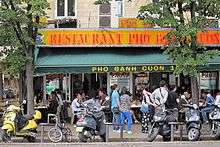
In the aftermath of the Vietnam War, Vietnamese refugees brought pho to many countries. Restaurants specializing in pho appeared in numerous Asian enclaves and Little Saigons, such as in Paris and in major cities in the United States, Canada and Australia.[29][30] In 1980, the first of hundreds of pho restaurants opened in the Little Saigon in Orange County, California.[31]
In the United States, pho began to enter the mainstream during the 1990s, as relations between the U.S. and Vietnam improved.[30] At that time Vietnamese restaurants began opening quickly in Texas and California, spreading rapidly along the Gulf and West Coasts, as well as the East Coast and the rest of the country. During the 2000s, pho restaurants in the United States generated US$500 million in annual revenue, according to an unofficial estimate.[32] Pho can now be found in cafeterias at many college and corporate campuses, especially on the West Coast.[30]
The word "pho" was added to the Shorter Oxford English Dictionary in 2007.[33] Pho is listed at number 28 on "World's 50 most delicious foods" compiled by CNN Go in 2011.[34] The Vietnamese Embassy in Mexico celebrated Pho Day on April 3, 2016, with Osaka Prefecture holding a similar commemoration the following day.[35] Pho has been adopted by other Southeast Asian cuisines, including Lao and Hmong cuisine.[5] It sometimes appears as "Phô" on menus in Australia.
Etymology and origins
| Pho | |
|---|---|
| Vietnamese name | |
| Vietnamese alphabet | phở |
| Chữ Nôm | |
Reviews of 19th and 20th century Vietnamese literature have found that pho entered the mainstream sometime in the 1910s. Phạm Đình Hổ's 1827 Hán-Nôm dictionary Nhật dụng thường đàm includes an entry for rice noodles (traditional Chinese: 玉酥餅; ; Vietnamese: ngọc tô bính) with the definition 羅𩛄普𤙭 (Vietnamese: là bánh phở bò; "is beef pho noodle"), borrowing a character ordinarily pronounced "phổ" or "phơ" to refer to pho.[37] Georges Dumoutier's extensive 1907 account of Vietnamese cuisine omits any mention of pho,[9] while Nguyễn Công Hoan recalls its sale by street vendors in 1913.[38] A 1931 dictionary is the first to define phở as a soup: "from the word phấn. A dish consisting of small slices of rice cake boiled with beef."[9][16][39]
Possibly the earliest English-language reference to pho was in the book Recipes of All Nations, edited by Countess Morphy in 1935: In the book, pho is described as "an Annamese soup held in high esteem ... made with beef, a veal bone, onions, a bayleaf, salt, and pepper, and a small teaspoon of nuoc-mam."[40]
There are two prevailing theories on the origin of the word phở and, by extension, the dish itself. As author Nguyễn Dư notes, both questions are significant to Vietnamese identity.[14]
From French
French settlers commonly ate beef, whereas Vietnamese traditionally ate pork and chicken and used cattle as beasts of burden.[22][41] Gustave Hue (1937) equates cháo phở to the French beef stew pot-au-feu (literally, "pot on the fire").[9] Accordingly, Western sources generally maintain that phở is derived from pot-au-feu in both name and substance.[3][9][42] However, several scholars dispute this etymology on the basis of the stark differences between the two dishes.[9][18][43] Another suggestion of a separate origin is that pho in French has long been pronounced [fo] rather than [fø]: in Jean Tardieu's Lettre de Hanoï à Roger Martin Du Gard (1928), a soup vendor cries "Pho-ô!" in the street.[24]
Many Hanoians explain that the word phở derives from French soldiers' ordering "feu" (fire) from gánh phở, referring to both the steam rising from a bowl of pho and the wood fire seen glowing from a gánh phở in the evening.[16]
Food historian Erica J. Peters argues that the French have embraced pho in a way that overlooks its origins as a local improvisation, reinforcing "an idea that the French brought modern ingenuity to a traditionalist Vietnam".[24]
From Cantonese
Hue and Eugèn Gouin (1957) both define phở by itself as an abbreviation of lục phở. Elucidating on the 1931 dictionary, Gouin and Lê Ngọc Trụ (1970) both give lục phở as a corruption of ngưu nhục phấn (Chinese: 牛肉粉; Cantonese Yale: ngau4 yuk6 fan2; "cow meat noodles"), which was commonly sold by Chinese immigrants in Hanoi.[9] ([ɲ] is an allophone of /l/ in some northern dialects of Vietnamese.)
Some scholars argue that pho (the dish) evolved from xáo trâu, a Vietnamese dish common in Hanoi at the turn of the century. Originally eaten by commoners near the Red River, it consisted of stir-fried strips of water buffalo meat served in broth atop rice vermicelli.[44] Around 1908–1909, the shipping industry brought an influx of laborers. Vietnamese and Chinese cooks set up gánh to serve them xáo trâu but later switched to inexpensive scraps of beef[9][10] set aside by butchers who sold to the French.[45] Chinese vendors advertised this xáo bò by crying out, "Beef and noodles!" (Cantonese Yale: ngàuh yuhk fán; Vietnamese: ngưu nhục phấn).[18] Eventually the street cry became "Meat and noodles!" (Chinese: 肉粉; Cantonese Yale: yuhk fán; Vietnamese: nhục phấn), with the last syllable elongated.[11][16] Nguyễn Ngọc Bích suggests that the final "n" was eventually dropped because of the similar-sounding phẩn (traditional Chinese: 糞; simplified Chinese: 粪; "excrement").[8][46] The French author Jean Marquet refers to the dish as "Yoc feu!" in his 1919 novel Du village-à-la cité.[45] This is likely what the Vietnamese poet Tản Đà calls "nhục-phở" in "Đánh bạc" ("Gambling"), written around 1915–1917.[14][43]
Phở uses a common Chinese Rice noodle called (Chinese: 河粉; Cantonese Yale: ho4 fen3; "Ho Fun") which is believed to have originated in Shahe, Guangdong, China.[47] The Cantonese also use the word (Chinese: 河; Cantonese Yale: ho4 ho4*2; "(Sha)he noodles") as well as (Chinese: 牛肉粉; Cantonese Yale: ngau4 yuk6 fan2; "cow meat noodles") to describe Phổ。 The two words share close approximation and could be a cognate of one another when considering varying regional and dialectical pronunciation differences.
Ingredients and preparation
| Wikibooks Cookbook has a recipe/module on |
Pho is served in a bowl with a specific cut of flat rice noodles in clear beef broth, with thin cuts of beef (steak, fatty flank, lean flank, brisket). Variations feature slow-cooked tendon, tripe, or meatballs in southern Vietnam. Chicken pho is made using the same spices as beef, but the broth is made using chicken bones and meat, as well as some internal organs of the chicken, such as the heart, the undeveloped eggs, and the gizzard.[48][49]
When eating at phở stalls in Vietnam, customers are generally asked which parts of the beef they would like and how they want it done.
Beef parts including:
- Tái băm: Rare beef patty, beef is minced by a chopping knife right before serving
- Tái: Medium rare meat
- Tái sống: Rare meat
- Tái chín: Mixture of medium rare meat and pre-cooked well-done meat, the default serving in most pho restaurants
- Tái lăn: Meat is sauteed before adding to the soup
- Tái nạm: Mix of medium rare meat with flank
- Nạm: Flank cut
- Nạm gầu: Brisket
- Gân: Tendons
- Sách: Beef tripe
- Tiết: Boiled beef blood
- Bò viên: Beef ball
- Trứng tái: Poached chicken egg (served in a separated bowl)
For chicken phở, options might include:
- Gà đùi: Chicken thigh
- Gà lườn: Chicken breast
- Lòng gà: Chicken innards
- Trứng non: Immature chicken eggs
Noodles

The thick dried rice noodle that is usually used is called bánh phở, but some versions may be made with freshly made rice noodles called bánh phở tươi in Vietnamese or kuay tiao.[50][51] These noodles are labeled on packaging as bánh phở tươi (fresh pho noodles) in Vietnamese, 新鲜潮洲粿條 (fresh Chaozhou kuy teav) in Chinese, 월남 쌀 국수 (Vietnamese rice noodle) in Korean, and ก๋วยเตี๋ยวเส้นเล็ก (thin kuy teav) in Thai.[52] The pho noodle are usually medium-width, however, people from different region of Vietnam will prefer different widths.
Broth

The soup for beef pho is generally made by simmering beef bones, oxtails, flank steak, charred onion, charred ginger and spices. For a more intense flavor, the bones may still have beef on them. Chicken bones also work and produce a similar broth. Seasonings can include Saigon cinnamon or other kinds of cinnamon as alternatives (may use usually in stick form, sometimes in powder form in pho restaurant franchises overseas), star anise, roasted ginger, roasted onion, black cardamom, coriander seed, fennel seed, and clove.[53] The broth takes several hours to make.[49] For chicken pho, only the meat and bones of the chicken are used in place of beef and beef bone. The remaining spices remain the same, but the charred ginger can be omitted, since its function in beef pho is to subdue the quite strong smell of beef.
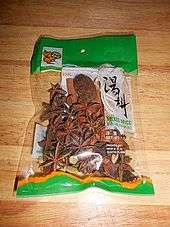
The spices, often wrapped in cheesecloth or a soaking bag to prevent them from floating all over the pot, usually contain cloves, star anise, coriander seed, fennel, cinnamon, black cardamom, ginger, and onion.
Careful cooks often roast ginger and onion over an open fire for about a minute before adding them to the stock, to bring out their full flavor. They also skim off all the impurities that float to the top while cooking; this is the key to a clear broth. Nước mắm (fish sauce) is added toward the end.
Garnishes
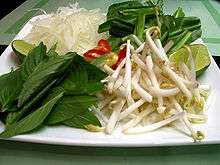
Vietnamese dishes are typically served with many greens, herbs, vegetables, and various other accompaniments, such as dipping sauces, hot and spicy pastes such as Sriracha, and a squeeze of lime or lemon juice; it may also be served with hoisin sauce. The dish is garnished with ingredients such as green onions, white onions, Thai basil (not to be confused with sweet basil), fresh Thai chili peppers, lemon or lime wedges, bean sprouts, and cilantro (coriander leaves) or culantro. Fish sauce, hoisin sauce, chili oil and hot chili sauce (such as Sriracha sauce) may be added to taste as accompaniments.[49][54]
Several ingredients not generally served with pho may be ordered by request. Extra-fatty broth (nước béo) can be ordered and comes with scallions to sweeten it. A popular side dish ordered upon request is hành dấm, or vinegared white onions.
Styles of pho
Regional variants
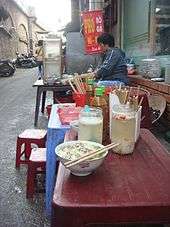
The several regional variants of pho in Vietnam, particularly divided between "Northern pho" (phở Bắc) and "southern pho" or "Saigon pho" (phở Sài Gòn). Northern pho by the use of fatty stock, blanched whole green onion, and garnishes offered generally include only diced green onion and cilantro, garlic, chili sauce and quẩy. On the other hand, southern Vietnamese pho broth is a clearer stock and is consumed with bean sprouts, fresh sliced chili, hoisin sauce and a greater variety of fresh herbs. Pho may be served with either pho noodles or kuy teav noodles (hủ tiếu).[55] The variations in meat, broth, and additional garnishes such as lime, bean sprouts, ngò gai (Eryngium foetidum), húng quế (Thai/Asian basil), and tương đen (bean sauce/hoisin sauce), tương ớt (hot chili sauce, e.g., Sriracha sauce) appear to be innovations made by or introduced to the South.[7] Another style of northern phở is Phở Nam Định from Nam Định city. Other provincial variations exist where pho is served with delicacy meats other than beef or chicken such as duck, buffalo, goat or veal.
Other phở dishes
Phở has many variants including many dishes bearing the name "phở", many are not soup-based:
- Hanoi specialties:
- Phở sốt vang: Wine-sauced pho, with beef stewed in red wine.
- Phở xào: sauteed pho noodles with beef and vegetables.
- Phở áp chảo: similar to phở xào but stir-fried with more oil and gets more burned.
- Phở cuốn: phở ingredients rolled up and eaten as a gỏi cuốn.
- Phở trộn (mixed Pho): pho noodles and fresh herbs and dressings, served as a salad.
- Other provinces:
- Phở chua: meaning sour phở is a delicacy from Lạng Sơn city.[56]
- Phở khô Gia Lai: an unrelated soup dish from Gia Lai.
- Phở sắn: a tapioca noodle dish from Quế Sơn District, Quảng Nam. It is closer to mì Quảng.
- Phở sa tế: pho noodles with chili and peanut sauce, came from Teochew immigrants in southern Vietnam.
- Phở vịt: duck pho, a specialty of Cao Bang province.
- Phở gan cháy: meaning grilled liver pho, a specialty found in Bắc Ninh city.
International variants include pho made using unconventional ingredients such as seafood, tofu and vegetable broth for vegetarians (phở chay), and a larger variety of vegetables, such as carrots and broccoli.
Vietnamese beef soup can also refer to bún bò Huế, which is a spicy beef noodle soup, is associated with Huế in central Vietnam.
Notable restaurants
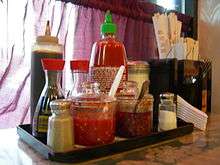
Famous pho shops in Hanoi are Phở Gia Truyền, Phở Thìn, Phở Bát Đàn, Phở Lý Quốc Sư.
Famous pho shops in Saigon included Phở Bắc Hải, Phở Công Lý, Phở Tàu Bay, Phở Tàu Thủy, and Phở Bà Dậu. Pasteur Street (phố phở Pasteur) was a street famous for its beef pho, while Hien Vuong Street (phố phở Hiền Vương) was known for its chicken pho.[57] At Phở Bình, American soldiers dined as Việt Cộng agents planned the Tết Offensive just upstairs.[58][59] Nowadays in Ho Chi Minh City, well known restaurants include: Phở Hùng, Phở Hòa Pasteur[60] and Phở 2000, which U.S. President Bill Clinton visited in 2000.[30][41]
One of the largest pho chain in Vietnam is Pho 24, a subsidiary of Highlands Coffee, with 60 locations in Vietnam and 20 abroad.[61] The largest pho chain in the United States is Phở Hòa, which operates over 70 locations in seven countries.[30][62][63] A similar restaurant named Pho 75 serves in the Washington, D.C. and Philadelphia, Pennsylvania areas in the United States.[64]
Many pho restaurants in the United States offer oversized helpings with names such as "train pho" (phở xe lửa), "airplane pho" (phở tàu bay), or "California pho" (phở Ca Li).[14][16][28] Some restaurants have offered a pho eating challenge, with prizes for finishing as much as 10 pounds (4.5 kg) of pho in one sitting,[65] or have auctioned special versions costing $5,000.[66][67]
See also
References
- Trịnh Quang Dũng (December 8, 2017). "Phở Việt - Kỳ 1: Khởi nguồn của phở". Tuổi Trẻ (in Vietnamese). Ho Chi Minh Communist Youth Union. Retrieved July 16, 2018.
- The Vietnamese spelling is phở – ending with an O with horn and hook above. However, the word is commonly simplified to pho in English-language text.
-
"pho, n.". Oxford English Dictionary (3rd ed.). Oxford University Press. March 2006.
"pho (British & World English)". Oxford Dictionaries. Oxford University Press. Retrieved 23 August 2013.
a type of Vietnamese soup, typically made from beef stock and spices to which noodles and thinly sliced beef or chicken are added. Origin: Vietnamese, perhaps from French feu (in pot-au-feu)
"pho (American English)". Oxford Dictionaries. Oxford University Press. Retrieved 13 July 2012.
"pho". The American Heritage Dictionary of the English Language (5 ed.). Houghton Mifflin Harcourt Publishing Company. 2011.
A soup of Vietnamese origin typically consisting of rice noodles, onions, herbs, seasonings, and thinly sliced beef or chicken in a clear broth.
"pho". Random House Dictionary. Random House. 2013. Retrieved 23 August 2013.
"pho". Collins English Dictionary. HarperCollins. Retrieved 23 August 2013.
Barber, Katherine, ed. (2005). "Pho". Canadian Oxford Dictionary (2nd ed.). Oxford University Press Canada. ISBN 9780191735219.
- Ha, Michelle (2017-06-30). "Pho: A Tale of Survival (Part 1 of 2)". The RushOrder Blog. Archived from the original on 2017-08-15. Retrieved 2017-08-15.
- Scripter, Sami; Yang, Sheng (2009). Cooking from the Heart: The Hmong Kitchen in America. University of Minnesota Press. p. 25. ISBN 978-1452914510.
Phở is made with small (1/16-inch-wide) linguine-shaped rice noodles labeled ‘bánh phở’.
- Thanh Nien staff (3 February 2012). "Vietnamese street food a gourmet's delight". Thanh Nien News. Retrieved 15 October 2012.
A visit to Vietnam would never be complete, Lister said, without the taste of food on the street, including phở - beef noodle soup,...
- Nguyen, Andrea Q. "History of Pho Noodle Soup". San Jose Mercury News, reprinted at Viet World Kitchen. Archived from the original on 2012-09-11. Retrieved 2011-10-22.
- Greeley, Alexandra (Winter 2002). "Phở: The Vietnamese Addiction". Gastronomica. Oakland, California: University of California Press. 2 (1): 80–83. doi:10.1525/gfc.2002.2.1.80. ISSN 1529-3262.
- Vương Trung Hiếu (July 17, 2012). "Nguồn Gốc Của Phở" [The Origins of Phở]. Văn Chương Việt (in Vietnamese). Retrieved May 16, 2013.
- Nguyễn Ngọc Tiến (2 August 2011). "Phở Hà Nội" [Hanoi Pho]. Hànộimới (in Vietnamese). Communist Party Committee of Hanoi. Retrieved 19 May 2013.
- An Chi (2010-06-15). "Lai lịch của món phở và tên gọi của nó" [Origin of the phở dish and its name]. An Ninh Thế Giới (in Vietnamese). Vietnam Ministry of Public Security. Retrieved 2013-05-18.
- Trịnh Quang Dũng (2011), "100 năm Phở Việt", Văn Hóa Học, retrieved 2016-07-16
- Nguyen, Andrea (2016), "The History of Pho", Lucky Peach, archived from the original on 2016-07-19, retrieved 2016-07-16
- Nguyễn Dư (February 2001). "Phở, phởn, phịa ..." [Pho, euphoria, innovation...]. Chim Việt Cành Nam (in Vietnamese). Retrieved 18 May 2013.
- Vu Hong Lien (2016). Rice and Baguette: A History of Food in Vietnam. London: Reaktion Books. p. 147. ISBN 9781780237046 – via Google Books.
Mobile phở was always sold by men, probably because the stockpot was too heavy for a woman to shoulder.
- Bùi Minh Đức (2009). "Tô phở Bắc và đọi bún bò Huế trên bình diện văn hóa đối chiếu" [‘Phở’ of the North and Beef Noodle of Huế as Compared Under a Cultural View]. Tạp chí Nghiên cứu và Phát triển (in Vietnamese). 1 (72). ISSN 1859-0152.
- Trịnh Quang Dũng (15 January 2010). "Phở muôn màu muôn vẻ" [Pho has ten thousand colors and ten thousand styles]. Báo Khoa Học Phổ Thông (in Vietnamese). Ho Chi Minh City Union of Science and Technology Associations. Retrieved 22 May 2013.
- Trịnh Quang Dũng (8 January 2010). "Khởi nguồn của phở" [Origins of pho]. Báo Khoa Học Phổ Thông (in Vietnamese). Ho Chi Minh City Union of Science and Technology Associations. Retrieved 21 May 2013.
- Thạch Lam (1943). [Adding to pho]. [Hanoi: 36 streets and districts] (in Vietnamese). Đời Nay Publishing House – via Wikisource.
- "A Bowl of Pho" Archived [Date missing] at kenh14.vn [Error: unknown archive URL], San Francisco Chronicle, November 1997
- Lê Văn Nghĩa (June 11, 2017). "Chuyện xưa – chuyện nay: Bánh mì Sài Gòn trong thơ" [Then and now: Saigon sandwiches in poetry]. Tuổi Trẻ (in Vietnamese). Ho Chi Minh Communist Youth Union. Retrieved April 3, 2018.
- Gibb, Camilla (2011). The Beauty of Humanity Movement: A Novel. p. 4.
The history of Vietnam lies in this bowl, for it is in Hanoi, the Vietnamese heart, that phở was born, a combination of the rice noodles that predominated after a thousand years of Chinese occupation and the taste for ...
- Xuan Phuong; Mazingarbe, Danièle (2004) [2001]. Myers, Jonathan E. (ed.). Ao Dai: My War, My Country, My Vietnam. Translated by Lynn M. Bensimon. Great Neck, New York: Emquad International. pp. 169–170. ISBN 0-9718406-2-8.
The soup that was presented to replace it was made of rotten rice noodles, a little bit of tough meat, and a tasteless broth. … As for the small street peddlers, they no longer had the right to sell pho, but instead, a vile soup in which there were noodles made of potato flour.
- Peters, Erica J. (2010). "Defusing Phở: Soup Stories and Ethnic Erasures, 1919–2009". Contemporary French and Francophone Studies. 14 (2): 159–167. doi:10.1080/17409291003644255.
- Renton, Alex (May 16, 2004). "Good morning, Vietnam". The Observer. Guardian Media Group. Retrieved December 26, 2014.
- Hoàng Linh (March 5, 2009). "Tản mạn về Phở" [Ramblings about Phở]. BBC Vietnamese (in Vietnamese). Retrieved May 16, 2013.
- Thanh Thảo (19 August 2012). "Từ bát phở 'không người lái'" [From a bowl of pho, 'no pilot']. Thanh Nien (in Vietnamese). Vietnam United Youth League. Retrieved 19 May 2013.
- Trịnh Quang Dũng (22 January 2010). "Phở theo thời cuộc" [Pho in the present day]. Báo Khoa Học Phổ Thông (in Vietnamese). Ho Chi Minh City Union of Science and Technology Associations. Retrieved 22 May 2013.
- "For Fantastic Pho, The Proof is in the Soup, Georgia Straight. April 2008.
- Loh, Laura (13 May 2002). "The Next Ethnic Dish of the Day: Vietnamese Pho". Los Angeles Times. Tribune Company. Retrieved 27 May 2013.
- Nguyen, Katherine (May 1, 2003). "Vietnamese Noodle Soup 'Pho' Scores Cross-Cultural Hit, Like Tacos, Sushi". Orange County Register. Santa Ana, California: Freedom Communications. ProQuest 464233345.
- Ngữ Yên (3 November 2005). "Phở Sài Gòn". Báo điện tử Sài Gòn Tiếp Thị (in Vietnamese). SGTT Media. Archived from the original on 19 December 2013. Retrieved 26 May 2013.
- Schuman, Kate, "Oxford's short dictionary adds hundreds of new words, including 'carbon footprint'", U-T San Diego, September 19, 2007.
- CNN Go.World's 50 most delicious foods Archived 2011-10-08 at the Wayback Machine. 21 July 2011. Retrieved 2012-09-09.
- Nhi Linh (April 4, 2016). "April 4 Pho Day in Japan". Vietnam Economic Times. Retrieved July 16, 2018.
- Trần Văn Kiệm, Giúp đọc Nôm và Hán Việt [Help reading Nom and Sino-Vietnamese], 2004, "Entry phở". This character was introduced in Unicode 8.0. Its Ideographic Description Sequence is ⿰米頗. 頗 is an abbreviated form.
- Phạm Đình Hổ (1827). "玉酥餅" [rice noodle]. Nhật dụng thường đàm.
- Nguyễn Công Hoan (2004). Nhớ và ghi về Hà Nội. Youth Publishing House. p. 94.
- Vũ Đức Vượng (14 November 2005). "Phở: tấm danh thiếp của người Việt". VietNamNet (in Vietnamese). Vietnam Ministry of Information and Communications. Translated into the English: "Pho: Common "name card" of Vietnamese". Sài Gòn Giải Phóng. Translated by Quang Hung. Communist Party Committee of Ho Chi Minh City. 14 November 2005. Archived from the original on 7 April 2013. Retrieved 4 April 2013.CS1 maint: others (link)
- Morphy, Marcelle (countess) (1935). "Dishes from many lands". Recipes of All Nations. New York: Wm. H. Wise & Co. p. 802. hdl:2027/coo.31924003591769.
PHO is the name of an Annamese soup held in high esteem. It is made with beef, a veal bone, onions, a bayleaf, salt, and pepper, and a small teaspoon of nuoc-man [sic], a typically Annamese condiment which is used in practically all their dishes. It is made from a kind of brine exuding from decaying fish, and in former days six years were required before it had reached full maturity. But in modern times the preparation has been put on the market, and can be made by chemical processes in a very short time.
- Apple, Raymond Walter, Jr. (13 August 2003). "Asian Journey; Looking Up an Old Love On the Streets of Vietnam". The New York Times. New York Times Company.
- Bloom, Dan, "What's that Pho? - French loan words in Vietnam hark back to the colonial days" Taipei Times, May 29, 2010.
- Nguyễn Dư (2006). Khơi Lại Dòng Xưa: Nghiên cứu - biên khảo văn hóa dân gian Việt Nam [Dredging up the past: Researching Vietnamese folk culture] (in Vietnamese). Hanoi: Nhà xuất bản Lao động. p. 110.
Tản Đà gọi nhục phấn là phục phơ. Chữ phấn chuyển qua phơ trước khi thành phở. Phơ của nhục phơ (chứ không phải feu của pot-au-feu) mới là tiền thân của phở.
- Siêu Hải (2000). Trăm Năm Truyện Thăng Long – Hà Nội (in Vietnamese). Youth Publishing House. pp. 373–375.
Nguồn gốc của nó là món canh thịt trâu xáo hành răm ăn với bún. Bà con ta thường gọi là xáo trâu rất phổ biến ở các chợ nông thôn và các xóm bình dân ở Hà Nội.
- Peters, Erica J. (16 October 2011). Appetites and Aspirations in Vietnam: Food and Drink in the Long Nineteenth Century. Rowman Altamira. p. 204. ISBN 978-0759120754.
Networks of Chinese and Vietnamese who cooked or butchered meat for the French most likely diverted beef remnants to street soup vendors …. By 1919, Jean Marquet reports hearing ‘Yoc Pheu!’ called out on the streets of Hanoi by Vietnamese selling beef soup …. Du village à la cité, Marquet’s novel about Vietnamese urbanization and radicalism, …. may be the earliest use of the word in print, and the earliest effort to label phở a uniquely Vietnamese dish.
- "pho". The American Heritage Dictionary of the English Language (5 ed.). Houghton Mifflin Harcourt Publishing Company. 2018. Retrieved July 16, 2018.
A soup of Vietnamese origin typically consisting of rice noodles, onions, herbs, seasonings, and thinly sliced beef or chicken in a clear broth.
- Shahe fen
- Johnathon Gold Pho Town; Noodle stories from South El Monte Dec. 12-18 2008 LA Weekly
- Diana My Tran (2003). The Vietnamese Cookbook. Capital Lifestyles (illustrated ed.). Capital Books. pp. 53–54. ISBN 1-931868-38-7. Retrieved 2011-10-22.
- Herbst, Sharon Tyler; Herbst, Ron (2007). The New Food Lover's Companion: More Than 6,700 A-to-Z Entries Describe Foods, Cooking Techniques, Herbs, Spices, Desserts, Wines, and the Ingredients for Pleasurable Dining. Barron's snippet. ISBN 978-0-7641-3577-4.
Medium-wide noodles (known as rice fettuccine, ban pho, ho fun, haw fun, gway tio, kway teow, kui teow, lai fen and sen lek) are considered an all-purpose noodle. They’re used in a wide variety of dishes (stir-frys, soups and salads) and as an accompaniment to meat dishes.
- Pailin's Kitchen. How to Make Fresh Rice Noodles "Ho Fun" ก๋วยเตี๋ยวเส้นใหญ่ - Hot Thai Kitchen!. Retrieved 2018-07-15.
- "Our Noodles". Sincere Orient. Retrieved July 15, 2018.
- Jessica Randhawa (November 30, 2018). Pho Recipe - How to make Vietnamese Noodle Soup. The Forked Spoon. Retrieved 2019-11-21.
- Gross, Matt (6 March 2014). "The Annoying Food Snob's Guide to Eating Pho With Sriracha". Bon Appétit. Condé Nast. Retrieved 2 January 2015.
- "Vietnamese Noodles 101: Banh Pho Flat Rice Noodles - Viet World Kitchen". Viet World Kitchen. Retrieved 12 November 2015.
- Vũ Thế Long (18 September 2009). "Phát hiện mới về phở (Bài 2): 'Giải phẫu' một bát phở bò" [New discoveries about pho (2nd article): 'Dissecting' a bowl of beef pho]. Báo Thể thao & Văn hóa (in Vietnamese). Vietnam News Agency. Retrieved 26 May 2013.
- Phan Nghị. "Phở Saigon xưa và nay" (in Vietnamese).
- Abt, Samuel (7 February 2008). "Restaurant in Vietnam remembers role in Tet offensive". International Herald Tribune. New York Times Company. Retrieved 15 August 2013.
Upstairs above Pho Binh, the Tet offensive was planned and ordered to begin.
- Cain, Geoffrey (4 November 2010). "Ho Chi Minh City's Secret Noodle Shop". Time. Time Inc. Retrieved 15 August 2013.
- Gross, Matt (5 May 2013). "Learning to Love 'the People's Food'". The New York Times. The New York Times Company. p. TR8.
At lunch, for example, I’d often order pho at the renowned Pho Hoa Pasteur.
- Nguyen, Lan Anh (14 February 2011). "Starting From Scratch". Forbes Asia. Forbes. Retrieved 27 May 2013.
- Hsu, Tiffany (21 March 2008). "Cooking up a growth plan". Los Angeles Times. Tribune Company. Retrieved 27 May 2013.
- "Company Information". Phở Hòa. 3 July 2012. Archived from the original on 29 May 2013. Retrieved 27 May 2013.
- Killham, Nina (September 17, 1989), "Than Van Thien: Soupmaker, Pho 75", Washington Post.
- Brewer, John (August 4, 2010). "Fooled by pho: Big white guy thought he was up to downing a 10-pound bowl of Vietnamese soup, but ...". St. Paul Pioneer Press. St. Paul, Minnesota: MediaNews Group. ProQuest 734897510.
- Shatkin, Elina (May 11, 2011). "World's Most Expensive Pho Goes on Auction Block". LA Weekly. Voice Media Group. Retrieved March 30, 2015.
- William-Ross, Lindsay (May 18, 2011). "Is There Such a Thing in L.A. as a $5,000 Bowl of Pho?". LAist. Gothamist. Retrieved March 30, 2015.
External links
| Wikimedia Commons has media related to: |
| Look up pho in Wiktionary, the free dictionary. |
- Warwicker, Michelle; Taylor, Anna-Louise (2013-09-27). "What is Vietnamese pho?". BBC Food.

.jpg)